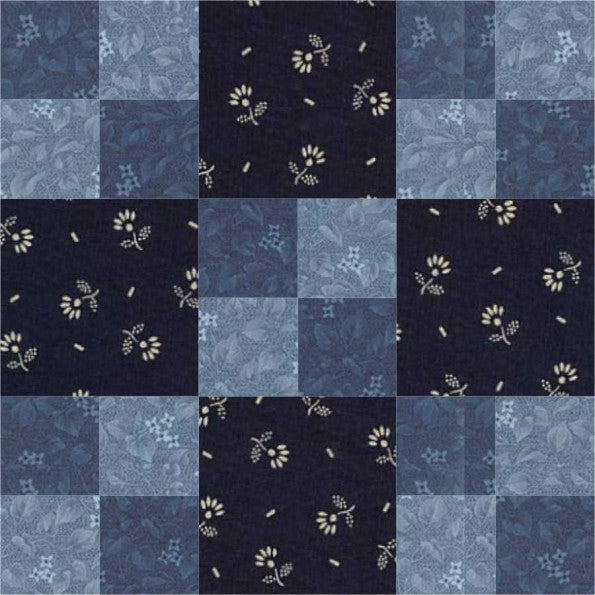
Double Four Patch Quilt Block Pattern

To keep these classes free please leave a donation for the teacher here. https://customclothingboutique.com/products/donat-to-motley-muse

Click here for a beginner in depth sewing class on all the basics. https://customclothingboutique.com/pages/quilting-knowledge
To sew a double four patch quilt block, you will need:
- Fabric squares in two different colors, each measuring 2 1/2 inches by 2 1/2 inches (you will need a total of 16 squares)
- Sewing machine
- Thread
- Iron and ironing board
- Rotary cutter and cutting mat
- Ruler
- Pins
Here are the steps to follow:
-
Cut out the fabric squares. You will need eight squares of each color.
-
Take one square of each color and place them right sides together. Pin them together.
-
Sew a 1/4 inch seam along one edge of the pinned squares. Backstitch at the beginning and end of the seam.
-
Press the seam allowance to one side. You can press it either towards the darker fabric or towards the lighter fabric, depending on your preference.
-
Take another square of the same color as the first square you sewed and place it right sides together with the remaining square of the other color. Pin them together.
-
Sew a 1/4 inch seam along one edge of the pinned squares. Backstitch at the beginning and end of the seam.
-
Press the seam allowance to one side.
-
Now you have two sets of four squares each. Place them right sides together, with the seams running in opposite directions. Pin them together.
-
Sew a 1/4 inch seam along one edge of the pinned sets. Backstitch at the beginning and end of the seam.
-
Press the seam allowance to one side.
-
Repeat steps 2-10 to make a total of four double four patch blocks.
-
Trim the blocks to 4 1/2 inches square.
Your double four patch quilt blocks are now complete and ready to be used in your quilt project!
The secret to the perfect four patch is all about ironing seams so that they butt together when the seams are joined. You may make the four patch by cutting individual squares if you want to make a scrappy quilt or only a few blocks to make with pre-joined strips. I'll take you through both methods.

Cut two A squares and two B squares in your required size. Chain piecing, join A square to a B square, right sides together, with a scant 1/4 inch seam allowance. Press towards the dark fabric.
This is your result:

This is also the result of cutting across pre-joined strips to create two units.
To make a standard four patch, the width of the unit cut from pre-joined strips is the same as the width of the original strips.
Press all the seams towards the dark fabric so that the seame butt-up.
Take the two A/B and place them right sides together, butting seams. Pin if required. Join with a scant 1/4 inch seam allowance, then press.

Wider Application:
You can apply this technique to all kinds of four patch blocks. As long as a block has a 4x4 grid, no matter how many pieces, the basic principles apply. It is repeated over and over again each four patch laying adjacent to the next. As long as you keep pressing seams in pairs of opposite directions, piecing will become easy.
All of the following blocks have 4x4 grids and can be pieaced as a four patch.

The secret to the nine patch is all about ironing seams so that they butt when they are joined.
Cut 5 A squares and 4 B squares in the required size.
Chain piecing, join a B square to only 3 of the A squares, right sides together, with a 1/4 inch seam allowance. No need to press just yet.
The result will be:

Next, take the remaining A and B squares and, chain piecing, join them to these units, right sides together, with a one 1/4 inch seam allowance:

Your result will be:

To make this faster you can cut strips.
Cut A and B strips for the appropriate width, and join them into A/B/A and B/A/B units. Note you will need twice the length of B/A/B strips, as there are two of these units. Once your strips are joined, right sides together, with a 1/4 inch seam allowance. Press every seam towards the dark fabric.
Cut across your pre-joined strips to create the units needed for the nine patch:

You will achieve the same result as above, but this method is faster.

To make a standard 9 patch, the width of the unit cut from pre-joined strips is the same as the width of the original strips.
Press all the seams to the dark fabric so that all the seems butt up.
Join the B/A/B units to your A/B/A units with butted seams, right sides together, with a 1/4 inch seam allowance.
The direction of the final, central seam is optional. But guided by the placement of the block in the larger scheme, and wherever possible, iron to facilitate budding the seam joints.
Wider Application:
Just as the 4 patch, you can apply this methodology to all kinds of 9 patch blocks. As long as the patch has an underlying 3x3 grid, no matter how many pieces, the basic principle applies. It is repeated over and over, each 9 patch laying adjacent to the next 9 patch. As long as you keep pressing seams in pairs of opposite directions, piecing will be smooth sailing.
Try these out. Each block has an underlying 3x3 grid, and can be pieaced as a 9 patch.

Sometimes it is not obvious which direction is the dark with complicated blocks like those above. Just remember the basic ironing plan is:

How to Resize Quilt Blocks:
